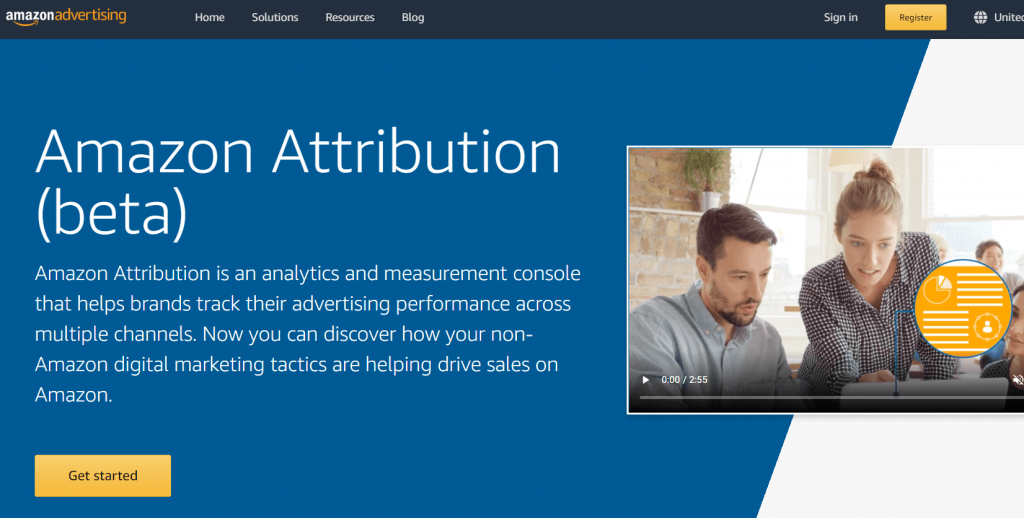Most Amazon sellers rely on marketing and advertising in order to find new customers and sell their products in a highly competitive market.
While advertising is a great way to increase your profile, it becomes virtually ineffective if you can’t easily see how your advertising campaigns are performing.
Today, I’m going to be talking about Amazon Attribution which offers a quick and easy way for Amazon sellers to track their campaigns so that they can make changes where necessary.
What is Amazon Attribution?

Part of Amazon DSP, Amazon Attribution is a platform that allows its users to track and monitor how their advertising is performing everywhere across the internet in order to give them an overview as to whether or not their campaigns are working.
Amazon Attribution works its magic by pulling traffic from numerous sites aside from Amazon (including Facebook and Google) to give advertisers fresh insights.
For example, an advertiser promoting their products through email or social media will be able to see which of these activities is performing best.
How’s it done?
Amazon Attribution tracks clicks and impressions from the pixels contained in an advert in order to create attribution tags that are then able to trace customers from their source.
This unique tool is able to let users track, trace, and monitor advertising performance like never before – saving them a lot of time and money.
How to Set Up Amazon Attribution
All you need to get started with Amazon Attribution is to be a current Amazon seller / vendor who has enrolled in Amazon Brand Registry.
Here’s how to get yourself set up:
- Click on over to https://advertising.amazon.com/amazon-attribution
- Scroll down and click onto the yellow ‘Sign Up Form’ button
- Fill in your details, including your vendor code
- Submit your details
- Verify your email address
Once your account is set up, you’ll be able to get cracking with generating attribution tags.
An attribution tag is essentially a tracking URL for your product listing which is then placed in your advert and any other digital media to drive customers straight to your product listing.
You can create an attribution tag as follows:
- Sign in to your Amazon Attribution account
- Select the name of the advertiser you want to create the tag for
- Click onto the button marked ‘New Order’
- For Google ads, select ‘Upload A File’ and follow the instructions given
- For any other kind of ads, select ‘Set Up An Order’
- Choose a product listing and click on ‘Add It’
- Go to the ‘Order Settings’ section and assign a name, tag or ID then click onto ‘Continue To Line Items’
- Go to the Publisher drop-down menu and browse the options in order to select where you want to post the link
- Under the Click-Through URL, assign an URL to your product listing and then press ‘Create’
That’s it, you’ve started your Amazon Attribution journey and monitoring your campaigns!
Once you’ve set up your adverts, it’s time to monitor them using Amazon Attribution’s reporting system.
This is done from your Reporting Insights dashboard within your account. From your dashboard, you can view progress, trace your adverts and download reports quickly and easily.
You can also choose which elements you wish to see reported.
The Benefits of Amazon Attribution

For regular sellers and advertisers, Amazon Attribution offers a myriad of benefits to help you make the most of your advertising spend.
Benefits include:
Identifying valuable advertising sources
Amazon Attribution gives you the ability to properly understand where your customers are coming from when you advertise your products.
This, in turn, allows you to focus your advertising on those areas which are most productive.
Budgeting
Once you understand where your advertising is most successful, you are then able to stop wasting money on the less successful platforms and redistribute it to where it will produce the best results.
Market Share
Being able to target your advertising more effectively means that you will subsequently increase your market share – which means getting ahead of the competition.
Visibility
A better understanding of your customers will help you to create more successful and more targeted adverts which, in turn, will increase your product’s visibility and, ultimately, lead to more sales.
Boost your ROI
Without knowing where you’re performing best, it’s almost impossible to calculate your Return On Investment.
Amazon Attribution allows you to do this by providing the necessary data.
Increase customer pool
Amazon Attribution gives you the tools to reach out to more targeted customers which, subsequently, allows you to easily increase your customer database.
By focussing advertising in the right places, you’re able to reach a pool of customers who are more likely to return.
You also then have the opportunity to re-engage these customers using Amazon DSP.
Asset creation
Once you know the areas in which your advertising does well, you can then drill down further by tweaking your advertising to more tightly target those customers.
You can also use this process to create demand on the platforms where your advertising isn’t doing quite so well.
Cost-free
As Amazon Attribution is currently at the Beta stage, there is no charge for using the service.
Amazon Attribution: Pros and Cons
Amazon Attribution sounds pretty great right so, let’s take a look at the Pros and Cons:
- Lets you see exactly where your advertising results are coming from
- Helps you to target customers more effectively
- Saves money by helping you target your advertising budget
- Free to use
- Amazon Attribution’s metrics are only currently available for sponsored brand adverts which are more expensive than sponsored product ads
- Amazon Attribution is only available for programmatic video and display ads purchased through Amazon DSP
- Only available for Amazon US and UK marketplaces right now
Things you need to know
- Amazon Attribution works on a 14-day period – which means that you have two weeks to monitor whether or not a customer returns
- Amazon Attribution only measures external traffic
- Amazon Attribution is only available to Amazon brand registered professional sellers and merchants
Amazon Attribution Reports
Amazon Attribution’s reporting is really where all the magic happens.
The comprehensive and easy to understand reporting system allows for both at-a-glance overviews and in-depth insights.
Amazon Attribution’s reporting works by tracking some major metrics which are:
Sales
The first, and probably most important metric, that this platform track is, of course, sales.
For any seller, the greatest measure of success is in how many products are sold.
Rather than just telling you what you’ve sold, Amazon Attribution breaks this down to tell you where sales are coming from in terms of:
- Total sales
- Total purchases
- Total added to cart
This metric also includes:
- Purchase rate – the number of purchases set against the number of impressions
- Purchase clicks – how many times a product has been purchased after a user has clicked on an ad
- Total purchase rate clicks – the number of purchases relating to promoted and brand halo products
This allows you to understand not just where sales are coming from but, also, cart abandonment figures from any given source.
Advertising sources
Amazon Attribution gives you a crystal clear view of the places in which your advertising is working hardest – across every platform throughout the internet.
Amazon detail page views
The detailed page view rate refers to the number of detail page views compared to the number of impressions.
Amazon Attribution lets you view data on how many times your page has been viewed and, how long internet users are spending on your page.
This is incredibly useful in helping you to work out your conversion rates and to figure out any underlying problems.
Conversions
Conversions are, of course, essential for any seller and, Amazon Attribution measures this important metric by breaking it down into:
- Add to cart views – the number of times a product is added to the cart after a user has viewed an advert
- Add to cart – the number of times a promoted product is added to the cart
- Click redirect – the metric which measures click-throughs and attribute conversions
- Click through rate – the number of click-throughs compared to the number of impressions
- Cumulative reach – the number of unique users who have viewed an ad from the start of the campaign
Case Study with Amazon Attribution
Bespoke meal preparation company, Premier Nutrition, is a great example of how Amazon Attribution can add value to a brand.
Having advertised its products for some time, Premier Nutrition felt that it probably wasn’t getting the most out of its advertising spend.
After signing up with Amazon Attribution, the company reported that it had grown its sales, quarter over quarter, by a staggering 96% with a 322% rise in year on year growth.
Media Supervisor, Jeremy Lopez said, ‘Amazon Attribution gave us deeper insight than the typical engagement and media metrics we receive from other solutions.
Using these insights, we were able to quickly optimize our investment strategy and generate greater ROI’.
Premier Nutrition is a very real demonstration of the kind of results which can be gained by using Amazon Attribution for just a short amount of time.
Summary
So, now, what you really want to know is, is Amazon Attribution any good?
If you only dabble in selling as a hobby, Amazon Attribution may not be right for you. Similarly, if you only have one or two products you may find that you won’t get the best out of this service.
If, however, you’re a professional seller, there are many good reasons for getting on board with Amazon Attribution.
As most sellers are only too aware, selling online is massively competitive and, steep competition on pricing means that many sellers see their profit margins dwindle as they struggle to remain competitive.
Amazon Attribution helps to offset this by focussing advertising budgets on the right platforms; which means that sellers are not constantly throwing away their cash on advertising campaigns that don’t convert.
Secondly, once sellers know where they should be advertising, they can then create more targeted adverts for those platforms which will help them to increase visibility and attract new customers – thus, helping them to stay ahead of the competition.
Finally, an added bonus of using Amazon Attribution is that it can very much help to increase visibility and awareness for your brand.
How? Once you start to focus your advertising in the right place, you’ll automatically be reaching more and more people who fit within your target audience.
As we all know, any tool which increases your brand’s profile without any cost to yourself is worth its weight in gold.
In my opinion, Amazon Attribution is a fantastic tool for any sellers who are looking to grow their product listings into a long term business.
This platform literally takes you by the hand and leads you to where your customers are – and then helps you to reach out to them.
The fact that Amazon Attribution is currently free to use really does make it a no-brainer for the serious seller and, I would suggest that interested parties get on board now just in case Amazon decides to charge for the service in the future.
You may also like:
Complete Guide: How to Advertise on Amazon to Maximize Your Sales
A Complete Guide To Advertise Amazon Products on Facebook
How to Use Social Media to Promote Your Amazon Business?
How to Build a Powerful Audience with Facebook Ads
Complete Guide for Amazon A+ Content: How to Create an Amazing Page
